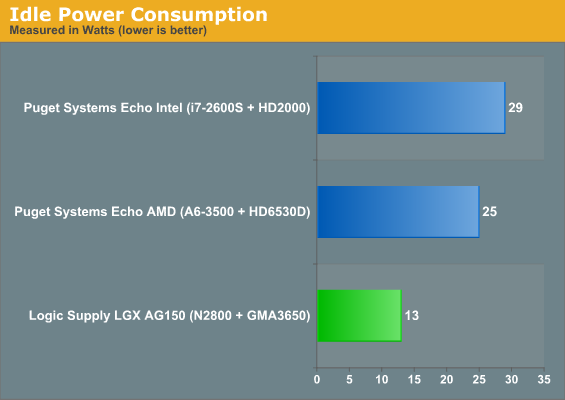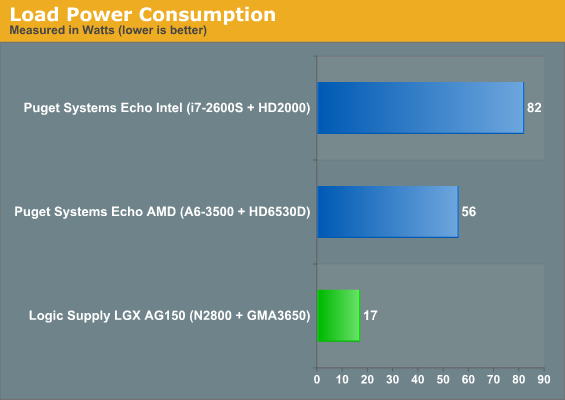Logic Supply LGX AG150 Fanless System Review: Cedar Trail or Cedar Trial?
by Dustin Sklavos on May 28, 2012 11:30 PM EST- Posted in
- kiosk
- Systems
- Atom
- Cedar Trail
User Experience and Power Consumption
Intel's Cedar Trail based Atom N2800 doesn't look completely bad, at least on paper. It offers a decent improvement over last generation's woefully anemic Atoms, and the GPU at least appears to address the major complaints we had with Pine Trail's pitiful GMA 3150. Unfortunately, Intel has had a history of getting their IGPs to perform well in Futuremark benchmarks only to have performance and compatibility fall apart in practical applications, and that history is repeating itself here.
After having used the LGX AG150, I don't have any trouble believing the rumors that Intel has been having serious problems with the PowerVR core behind the GMA 3650. I'm not going to fault Logic Supply for this; if you're going to build a fanless system that can be deployed cheaply and in significant numbers, I think it's hard to do better than what they've achieved here. However, the responsibility for some of the stability issues and/or lack of support should be placed squarely on Intel's shoulders.
The first review unit I received from Logic Supply had serious issues with screen tearing and stuttering even on the desktop, with or without Aero Glass enabled. When I checked for updated drivers and found them, the updated drivers essentially locked up the system and prevented me from re-entering Windows. Rather than have me go through the trouble of reformatting and trying to get Intel's drivers to work, Logic Supply simply sent me a second review unit that had the new GMA 3650 drivers slipstreamed into the Windows installation. Just think about how bad the situation would have to be to produce a paragraph like this one; the GMA 3650 drivers were incapable of handling a blank desktop. It didn't matter if I changed the resolution or reduced Aero Glass, it just wasn't happening.
The updated drivers fixed the situation...sort of. The GMA 3650 can now run Aero Glass at 1080p, but extremely slowly. Trying to move windows or even do anything results in a tremendous amount of lag in the system. Understanding Atom tends to be confined to the Aero-free Windows 7 Starter, it must be noted that the last generation of Atom processors was actually able to handle Aero Glass just fine. Circumstances are dire when Aero Glass gives your graphics solution problems.
What about H.264 support? Jarred took a quick look at an N2600-based netbook from ASUS here, but the bottom line is that while DXVA support is mostly in place, high definition playback from YouTube, Hulu, or Netflix is still largely out of the question. In 2012, when smartphones and tablets are able to handle most of these tasks, that's just not acceptable.
Most of these factors are beyond the control of Logic Supply, but thankfully the ones that are within Logic Supply's power are handled well: power consumption and thermals. Logic Supply advertises the system with a TDP of just 15 watts, and while our results weren't quite that low, they were still pretty good.


Idle consumption has come down tremendously on most modern processors, but a 32nm Atom still doesn't ask for much when it's not doing much. Load power does break the 15-watt TDP that Logic Supply advertises, but only by two watts, certainly still reasonable—plus, if Logic Supply isn't accounting for PSU efficiency, that would easily explain the extra 2W. Thermals for the system are also excellent; the RAM ran at a nearly consistent 50C, while the CPU cores never really broke 45C under sustained load. And of course, since the system is completely fanless and has no moving parts, meaning it also produces no noise.


_thumb.jpg)
_thumb.jpg)
_thumb.jpg)








46 Comments
View All Comments
hobbesmaster - Tuesday, May 29, 2012 - link
I'm assuming he meant POS as "Point of sale" instead of "piece of s***" The two often go hand in hand, but the issues are usually software!A lot of those systems are moving to USB though from what I understand. Regardless, this should handle an XGA touch screen fine which is probably all its intended to do.
They also list this under automotive, that wouldn't be a bad application either. You'd have a WVGA screen at max there.
beginner99 - Tuesday, May 29, 2012 - link
Even though its obviously intels lack of creating useful drivers once more as the producer of a system requiring such a driver i would not buy it if it doesn't work...so Logic IMHO is to blame too at least partially. But it seem to be the trend to release "faulty" products anyway.khimera2000 - Tuesday, May 29, 2012 - link
This review has some nice information, but it leaves so many questions that should not of cropped up. How does it perform against the last generation on both sides? how does it compare to the current generation from its competitor?The last time I checked it was the E-series that AMD marked as there "power efficient line" why is this being compared to an A6? Why was it not compared to an E-450, or at least a E-350? at least these two would be in the same area, and so would be perfect for comparison against an Atom N2800.
Without a point of comparison against other power efficient parts I look at the Data as a wash of useless. there's nothing in there that's relevant if its not seeing how it does against its competition.... and at least in my head that's the E-350, E-450, and VIA's cluster off product offerings.
I don't care who comes out on top, I just want to know how heavy the trade off is at this level of power draw, I want to know if bad drivers can result in a system that has to push hotter then its competiters, I would like to see how far these chips have advanced... also a brief rundown on each companies secret sauce would be a nice touch... refreshers always help :)
Spunjji - Tuesday, May 29, 2012 - link
Looks like you beat me to it! ;)I'm guessing the usual caveat of testing the systems they had to hand applies here, but you're right, the comparative data isn't of much use.
Credit where it's due though; this information does at least tell us that Atom is somehow more useless than ever on the desktop.
JarredWalton - Tuesday, May 29, 2012 - link
Bingo! Unfortunately, most of what we have on hand is limited, and I'm pretty sure none of us are interested in buying our own low-end Atom nettops. It's partly a problem of simply not getting enough of these types of systems for review, and when we do get systems they're often sent to different reviewers. Anand has played with a nettop at some point, so have I, and so has Ganesh. Most of those were a year ago or more, though, and so there's not a lot of overlap in the performance results.UrQuan3 - Monday, June 4, 2012 - link
Wish we could arm-twist LogicSupply a bit for the other review units since they seem to stock AMD E-series and Via Nano systems as well as Atoms.Spunjji - Tuesday, May 29, 2012 - link
For the curious:http://www.silentpcreview.com/Jetway_G-T40E
Pretty much what I'd imagined - Intel win for power consumption and thermals, AMD win for just about everything else. That 28nm shrink of Brazos needs to come sooner.
randinspace - Tuesday, May 29, 2012 - link
I think at least part of the answer to your question lies in the fact that Logic Supply themselves seems strangely (tragically? misguidedly?) married to the Atom if Brazos' presence in only one of their fanless systems is any indication.Spunjji - Tuesday, May 29, 2012 - link
A comparison to / mention of Brazos would have been nice, what with it being the prime competitor in this market! I'd really like to know how Intel's update changes the performance stakes, as Brazos was never that far ahead on the CPU side to begin with. I understand that you may not have had a system to hand but some passing comment would be lovely.silverblue - Tuesday, May 29, 2012 - link
Brazos is a fine competitor, however it'd be an unfair comparison as you mentioned above because of its higher power consumption and temperatures. Brazos-T is on the way which should improve on that.Ironically for AMD, Brazos is much faster at single threaded workloads than Atom; it's only when Atom's HT is leveraged that the two get much closer.